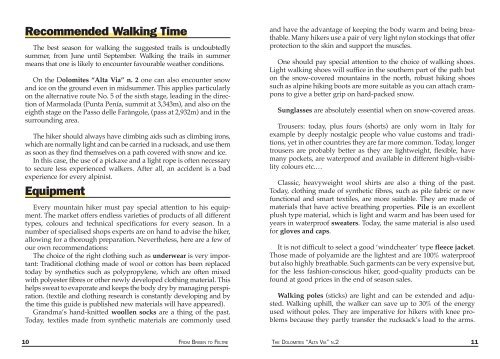Create successful ePaper yourself
Turn your PDF publications into a flip-book with our unique Google optimized e-Paper software.
Recommended Walking Time<br />
The best season for walking the suggested trails is undoubtedly<br />
summer, from June until September. Walking the trails in summer<br />
means that one is likely to encounter favourable weather conditions.<br />
On the Dolomites “Alta Via” n. 2 one can also encounter snow<br />
and ice on the ground even in midsummer. This applies particularly<br />
on the alternative route No. 5 of the sixth stage, leading in the direction<br />
of Marmolada (Punta Penía, summit at 3,343m), and also on the<br />
eighth stage on the Passo delle Faràngole, (pass at 2,932m) and in the<br />
surrounding area.<br />
The hiker should always have climbing aids such as climbing irons,<br />
which are normally light and can be carried in a rucksack, and use them<br />
as soon as they find themselves on a path covered with snow and ice.<br />
In this case, the use of a pickaxe and a light rope is often necessary<br />
to secure less experienced walkers. After all, an accident is a bad<br />
experience for every alpinist.<br />
Equipment<br />
Every mountain hiker must pay special attention to his equipment.<br />
The market offers endless varieties of products of all different<br />
types, colours and technical specifications for every season. In a<br />
number of specialised shops experts are on hand to advise the hiker,<br />
allowing for a thorough preparation. Nevertheless, here are a few of<br />
our own recommendations:<br />
The choice of the right clothing such as underwear is very important:<br />
Traditional clothing made of wool or cotton has been replaced<br />
today by synthetics such as polypropylene, which are often mixed<br />
with polyester fibres or other newly developed clothing material. This<br />
helps sweat to evaporate and keeps the body dry by managing perspiration.<br />
(textile and clothing research is constantly developing and by<br />
the time this guide is published new materials will have appeared).<br />
Grandma’s hand-knitted woollen socks are a thing of the past.<br />
Today, textiles made from synthetic materials are commonly used<br />
and have the advantage of keeping the body warm and being breathable.<br />
Many hikers use a pair of very light nylon stockings that offer<br />
protection to the skin and support the muscles.<br />
One should pay special attention to the choice of walking shoes.<br />
Light walking shoes will suffice in the southern part of the path but<br />
on the snow-covered mountains in the north, robust hiking shoes<br />
such as alpine hiking boots are more suitable as you can attach crampons<br />
to give a better grip on hard-packed snow.<br />
Sunglasses are absolutely essential when on snow-covered areas.<br />
Trousers: today, plus fours (shorts) are only worn in Italy for<br />
example by deeply nostalgic people who value customs and traditions,<br />
yet in other countries they are far more common. Today, longer<br />
trousers are probably better as they are lightweight, flexible, have<br />
many pockets, are waterproof and available in different high-visibility<br />
colours etc.…<br />
Classic, heavyweight wool shirts are also a thing of the past.<br />
Today, clothing made of synthetic fibres, such as pile fabric or new<br />
functional and smart textiles, are more suitable. They are made of<br />
materials that have active breathing properties. Pile is an excellent<br />
plush type material, which is light and warm and has been used for<br />
years in waterproof sweaters. Today, the same material is also used<br />
for gloves and caps.<br />
It is not difficult to select a good ‘windcheater’ type fleece jacket.<br />
Those made of polyamide are the lightest and are 100% waterproof<br />
but also highly breathable. Such garments can be very expensive but,<br />
for the less fashion-conscious hiker, good-quality products can be<br />
found at good prices in the end of season sales.<br />
Walking poles (sticks) are light and can be extended and adjusted.<br />
Walking uphill, the walker can save up to 30% of the energy<br />
used without poles. They are imperative for hikers with knee problems<br />
because they partly transfer the rucksack’s load to the arms.<br />
10 FROM BRIXEN TO FELTRE THE DOLOMITES “ALTA VIA” N.2 11

















